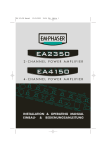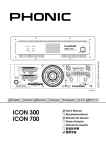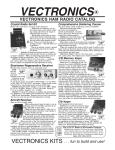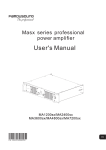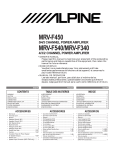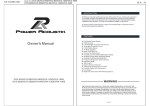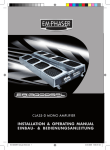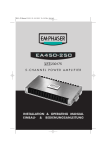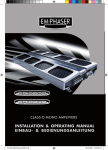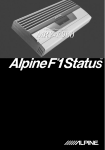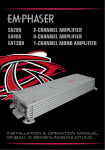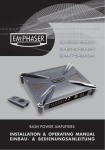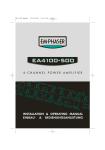Download EMPHASER EA475-350D Specifications
Transcript
EM Digital 4/5-CH Manual 2004 26.03.2004 11:39 Uhr Seite 1 2-, 4- & 5-CHANNEL DIGITAL AMPLIFIERS INSTALLATION & OPERATING MANUAL EINBAU- & BEDIENUNGSANLEITUNG EM Digital 4/5-CH Manual 2004 26.03.2004 11:39 Uhr Seite 2 CONTENTS 1. DESIGN FEATURES 2. CONNECTIONS & CONTROLS 6-9 FRONT PANEL CONNECTION & CONTROLS 6-7 REAR PANEL CONNECTIONS & CONTROLS 8-9 3. 5 INSTALLATION PLANNING 10 PLAN OF ATTACK 10 MOUNTING LOCATION 10 INFO ABOUT WIRE CROSS SECTIONS AND CABLE QUALITY 11 MAIN POWER CABLE CROSS SECTION 11 RCA INTERCONNECTS 11 LOUDSPEAKER CABLES 11 MINIMAL SPEAKER IMPEDANCES 11 5. AMPLIFIER MOUNTING 12 6. CABLE ROUTING 4. 12-13 RCA INTERCONNECTS AND REMOTE WIRING CONNECTION OF LOUDSPEAKER WIRES MAIN POWER CABLE ROUTING 7. ADJUSTMENT OF THE CONTROL FUNCTIONS 13 SELECTING THE OPERATION MODE FOR SATELLITE SPEAKERS 13 SELECTING A CROSSOVER FREQUENCY POINT FOR SATELLITE SPEAKERS 13 SELECTING A CROSSOVER FREQUENCY POINT FOR KICKBASS SPEAKERS 14 LOWPASS CROSSOVER FREQUENCY ADJUSTMENTS FOR SUBWOOFERS 14 SUBSONIC CROSSOVER FREQUENCY ADJUSTMENT FOR SUBWOOFERS 14 ADJUSTMENT OF THE INPUT GAIN CONTROLS 15 PHASE SHIFT CONTROL 15 8. TECHNICAL SPECIFICATIONS 29 9. EMPHASER LIMITED WARRANTY 30 WARRANTY LIMITATIONS 30 10. WARRANTY CARD 2 32 EM Digital 4/5-CH Manual 2004 26.03.2004 11:39 Uhr Seite 3 INHALT 1. TECHNISCHER AUFBAU / MERKMALE 2. ANSCHLÜSSE & BEDIENUNGSELEMENTE 18-21 EINGÄNGE & FUNKTIONEN AM FRONT PANEL 18-19 EINGÄNGE & FUNKTIONEN AM REAR PANEL 20-21 3. 17 PLANUNG DER INSTALLATION 22 MONTAGEORT 22 INFO’S ZU DEN KABELQUERSCHNITTEN & QUALITÄT 23 STROMKABEL QUERSCHNITT 23 CINCHKABEL 23 LAUTSPERCHER KABEL 23 MINIMALE LASTIMPEDANZ DER LAUTSPRECHER 23 5. MONTAGE DES VERSTÄRKERS 24 6. VERKABELUNG / ELEKTRISCHER ANSCHLUSS 25 VERLEGEN VON CINCH- UND REMOTE KABELN 25 ANSCHLUSS DER LAUTSPRECHERKABEL 25 VERLEGEN UND ANSCHLUSS DER HAUPT-STROMKABEL 25 EINSTELLUNGEN AN DER FREQUENZWEICHE 26 WAHL DES „OPERATING MODES“ DER FREQUENZWEICHE 26 WAHL DER TRENNFREQUENZ FÜR DIE SATELLITENSYSTEME 26 WAHL DER TRENNFREQUENZEN FÜR EIN KICKBASS-SYSTEM 26 LOWPASS EINSTELLUNG FÜR DEN SUBWOOFER 27 SUBSONIC HOCHPASS TRENNFREQUENZ FÜR DEN SUBWOOFER 27 ANPASSUNG DER EINGANGSEMPFINDLICHKEIT 27 EINSTELLUNG DES PHASE SHIFTS 28 8. TECHNICAL SPECIFICATIONS 29 9. EMPHASER GARANTIE-BESTIMMUNGEN 30 GARANTIE-EINSCHRÄNKUNGEN 30 4. 7. 10. GARANTIEKARTE 32 3 EM Digital 4/5-CH Manual 2004 26.03.2004 11:39 Uhr Seite 4 Congratulations! And thank you for choosing this EMPHASER car audio amplifier! You now own a product of uncompromising engineering, true craftsmanship and unprecedented functionality. To maximize the performance of this amplifier and your car audio system install, we recommend that you acquaint yourself thoroughly with all capabilities and features of this EMPHASER amplifier unit. Please read this manual carefully, before attempting the installation of this amplifier. Please retain this manual and your purchasing / installation receipts for future reference. IMPORTANT NOTICE: In case you are installing your EMPHASER amplifier yourself, you should have your installation checked and approved by an authorized professional EMPHASER dealer/installer, in order to qualify for full warranty protection and also, to reach maximum power- and audio performance possible with your individual car audio system. 4 EM Digital 4/5-CH Manual 2004 26.03.2004 11:39 Uhr Seite 5 1. DESIGN FEATURES ■ DIGITAL CAR AUDIO AMPLIFIER for a cross-over controlled amplification of satellite speaker systems, kickwoofers and subwoofer systems ■ REMOTE LOWPASS LEVEL CONTROL to set the subwoofer volume level from the driver’s seat ■ REGULATED MOSFET POWER SUPPLY to sustain very high output power into low impandance loads ■ 1 OHM LOAD STABILITY to drive speaker systems with very low impedance, sustaining very high power output levels ■ ELECTRONIC CROSSOVER with 12 dB/oct. or 18/24 dB/oct. slope steepness and fully variable cit-in / cut-off frequencies for highpass, bandpass or subsonic filtering of the individual channels ■ 2AWG POWER INPUT TERMINALS for direct connection of 35mm2 main power wires ■ ADVANCED PROTECTION CIRCUITRY to safe-guard the amplifier from short-circuits at the speaker outputs, DC offset voltage at the outputs and overheating of power electronics ■ ADJUSTABLE RCA INPUT SENSITIVITY from 200mV to 6V to provide a good match with the line-output levels of almost any head-unit ■ EXTERNAL FUSES on the input side-panel, equipped with Maxi type fuse holders 5 EM Digital 4/5-CH Manual 2004 26.03.2004 11:39 Uhr Seite 6 2. CONNECTIONS & CONTROLS FRONT PANEL CONNECTIONS & CONTROLS 1a/1b RCA INPUTS 1/2-CH Low-level stereo RCA signal input for connection of channels 1 & 2 to head-unit 2a/2b RCA INPUTS 3/4-CH Low-level stereo RCA signal input for connection of channels 3 & 4 to head-unit 3a/3b RCA INPUTS 5/6-CH Low-level stereo RCA signal input for connection of channels 5 & 6 to head-unit 4 HIGH PASS FREQUENCY CONTROL 1/2-CH Control for the highpass frequency adjustment of the electronic crossover driving channels 1&2 5 OPERATION MODE SWITCH 1/2-CH Switch to set the operation mode of the electronic crossover driving channels 1 & 2 6 LOW PASS FREQUENCY CONTROL 1/2-CH Control for the lowpass frequency adjustment of the electronic crossover driving channels 1&2 7 INPUT GAIN CONTROL 1/2-CH Input level control for 1/2-CH amplifier section - allowing to match the output voltage of the head-unit’s RCA line-outs to the amplifier input section 8 HIGH PASS FREQUENCY CONTROL 3/4-CH Control for the highpass frequency adjustment of the electronic crossover driving channels 3&4 9 OPERATION MODE SWITCH 3/4-CH Switch to set the operation mode of the electronic crossover driving channels 3 & 4 10 LOW PASS FREQUENCY CONTROL 3/4-CH Control for the lowpass frequency adjustment of the electronic crossover driving channels 3&4 11 INPUT GAIN CONTROL 3/4-CH Input level control for 3/4-CH amplifier section - allowing to match the output voltage of the head-unit’s RCA line-outs to the amplifier input section 12 POWER LED / PROTECTION LED Green “operation” LED, signaling correct operation of the amplifier, red LED signalling faulty speaker connections or general malfunction of the amplifier 13 SUBSONIC HIGH PASS FREQUENCY CONTROL Control for the subsonic highpass frequency adjustment of the electronic crossover driving the corresponding channel pair 14 LOW BASE FREQUENCY CONTROL 5-CH Control for the lowpass frequency adjustment of the electronic crossover driving channels 5 6 EM Digital 4/5-CH Manual 2004 26.03.2004 11:39 Uhr Seite 7 15 INPUT GAIN CONTROL 5-CH Input level control for 5-CH amplifier section - allowing to match the output voltage of the head-unit’s RCA line-outs to the amplifier input section 16 PHASE SHIFT CONTROL Control for the relative phase adjustment of the subwoofer(s) connected to the amplifier output terminals of the corresponding channel pair 17 REMOTE LOW PASS LEVEL INPUT Telephone jack port for connection with the dash-mounted low-pass level remote unit 7 16 6 13 17 12 1a/1b POWER EA 2500D 2a/2b LINE INPUT LCH 0 180 MIN PHASE SHIFT MAX 40Hz 400Hz 10Hz LOW PASS LEVEL 50Hz RCH PROTECTION REMOTE SUBSONIC LCH RCH LINE OUT EA2500D 1a/1b 2a/2b 4 5 7 6 8 9 10 11 12 POWER EA4150D 1CH 3CH 2CH 4CH 40Hz HI PASS 400Hz HI FLAT LP 40Hz 1/2CH X-OVER 400Hz MIN LOW PASS MAX 40Hz HI 400Hz FLAT LP 40Hz 3/4CH X-OVER HI PASS LEVEL 400Hz MAX MIN LOW PASS PROTECTION LEVEL LINE INPUT EA4150D 1a/1b 2a/2b 3a/3b EA475-350D 1CH 3CH 5CH 4 5 X-OVER HI PASS 8 7 1/2CH LEVEL 9 10 X-OVER HI PASS LOW PASS 11 12 3/4CH LEVEL POWER PROTECT 40Hz 2CH 4CH 6CH 400Hz HI FLAT MIN MAX 40Hz 400Hz 10Hz 50Hz HI FLAT LP/BP BAND PASS 40Hz 400Hz 40Hz 400Hz MIN MAX SUBSONIC LOW PASS 5CH LEVEL 13 14 15 MIN MAX 0 180 PHASE SHIFT 5CH REMOTE LINE INPUT EA475-350D 16 17 7 EM Digital 4/5-CH Manual 2004 26.03.2004 11:39 Uhr Seite 8 2. CONNECTIONS & CONTROLS REAR PANEL CONNECTIONS & CONTROLS 18 FUSES Two ATC Maxi fuses for protection of the amplifier electronics against overload or wrong operation / manipulation 19 REMOTE INPUT TERMINAL Terminal to connect the amplifier to the automatic (remote) turn-on / turn-off lead of the head unit 20 POWER INPUT TERMINAL „+ 12 V“ Terminal to connect the amplifier to the positive +12V pole of the car battery 21 POWER INPUT TERMINAL „GND“ Terminal to connect the amplifier to the negative or ground pole of the car battery 22 SPEAKER OUTPUT TERMINALS Output terminal to connect the speakers in stereo or bridged mode to the amplifier 8 EM Digital 4/5-CH Manual 2004 26.03.2004 11:39 Uhr Seite 9 REAR PANEL CONNECTIONS & CONTROLS 7 16 6 13 17 12 1a/1b POWER EA 2500D LINE INPUT LCH 0 180 PHASE SHIFT MIN MAX 40Hz 400Hz 10Hz LOW PASS LEVEL 50Hz SUBSONIC 2a/2b RCH PROTECTION REMOTE LCH RCH LINE OUT EA2500D 19 18 20 21 +12V GND 22 MONO + REM + 1CH - + 3CH - + 2CH + 4CH - FUSE + - MONO SPEAKER OUTPUT POWER INPUT EA4150D 18 19 20 21 22 MONO + REM +12V GND + 1CH - + 3CH - + 2CH + 4CH - 5CH + - 5CH - FUSE + POWER INPUT MONO - SPEAKER OUTPUT EA475-350D 9 EM Digital 4/5-CH Manual 2004 26.03.2004 11:39 Uhr Seite 10 3. INSTALLATION PLANNING PLAN OF ATTACK Before you proceed to install this EMPHASER amplifier, it is recommended to map out the complete audio system and the respective wiring required. Consider all additional electrical requirements and accessories, such as power cables, interconnect cables etc., but also a safe mounting, sufficient ventilation and accessability of the fuses and the side panel controls. Please note that - because of possible interference problems with the existing car electrics and electronics - especially the routing of the signal cables and the chassis ground connection will have a profound impact on a trouble-free operation of the amplifier. MOUNTING LOCATION The mounting location should be carefully selected and in the interest of passive driver and passenger safety, the amplifier must be securely mounted. Any mounting position – preferably in the trunk compartment – that allows sufficient cooling and solid mounting is okay. Make sure there is no wiring harness, fuel tank etc. behind or below the mounting surface, that may be damaged by the drilling of the holes for the amplifier mounting screws. After installation, there should be a clearance of at least 5cm on all sides including the top of the amplifier heatsink. Make sure the unit is not exposed to direct sunlight, humidity, water, oil or spill of other fluids that may enter the amplifier. 10 EM Digital 4/5-CH Manual 2004 26.03.2004 11:39 Uhr Seite 11 4. INFO ABOUT WIRE CROSS SECTIONS AND CABLE QUALITY MAIN POWER CABLE CROSS SECTION EMPHASER recommends a minimum power cable cross-section (5m total length) of 35mm2 for the main and the ground power supply cables. These recommendations guarantee trouble-free operation of your amplifier, giving you full power output. Using main power cables with cross sections smaller than 35mm2 will result in unnecessary overheating of the amplifier circuitry, distortion at high volume levels and it may even cause the thermal protection circuitry to trigger and shut-down the amplifier! RCA INTERCONNECTS For best performance of your EMPHASER amplifier, you should stick to high quality RCA interconnect cables. Use twisted pair or triple shielded types only. Keep in mind, the RCA interconnects should always be kept far away from any potential sources of electrical interference e.g. electronic vehicle management systems (engine computers, relays etc.) fuel pumps, wiring harnesses etc.! LOUDSPEAKER CABLES Use good quality speaker wires of minimum 2.5mm2, up to 4.0mm2 cross-section, depending on the necessary total length! MINIMUM SPEAKER IMPEDANCES The heat dissipation capacity of this amplifier series has been designed to cope with low impedance loads, such as 1 ohms for stereo speaker setups or 2 ohms in bridged mode operation. However, EMPHASER laboratories recommend to stay above 2 ohms in bridged operation mode, to guarantee a good damping factor to precisely control the connected speaker(s). 11 EM Digital 4/5-CH Manual 2004 26.03.2004 11:39 Uhr Seite 12 5. AMPLIFIER MOUNTING Attention! For your own safety, disconnect the positive battery terminal (+12V) or remove the main fuse in the positive power cable near the car battery, before you start any wiring work! Once the location where the amplifier will be mounted is defined, use the unit as a template for the marking of the mounting holes with pencil or felt-tip marker. The mounting holes should be pilot-drilled, using a 2,5mm or 3mm drill bit. Now secure the amplifier in its position by tightening the screws evenly and re-check proper fit after completion. Important! Never allow the heatsink of the amp to come in contact with metal surfaces of the vehicle. The resulting ground-loop can result in a loud hum! 6. CABLE ROUTING RCA INTERCONNECTS AND REMOTE WIRING Carefully run the audio signal interconnects, the remote lead and the cable of the remote low pass level boost unit (EA2500D & EA475-350D) from the head-unit or dashboard to the amplifier. As mentioned before, the audio signal cables should be routed separately from the power cables. Connect the remote (turn on/turn off) lead to the respective input terminal of the amplifier and to the remote output of your head-unit. Now you can connect the RCA interconnects to the respective outputs of your headunit and to the inputs of the amplifier. Pay attention to connect the stereo interconnects correspondingly, left is 1CH, right is always 2CH. If you want to drive a subwoofer system with your amplifier and use the lowpass level remote, you must find a good location to mount the remote control unit first. Fix the remote in place by using the self tapping screws and connect the remote wire to the remote device and the amplifier. Note: The EA2500D features one pair RCA line inputs, and another pair of RCA line-outputs. The RCA line outs are used to daisy chain the RCA input signal, for example if two or more EA2500D are intended to be driven by one RCA line-out signal from the head-unit. LOUDSPEAKER WIRE ROUTING Once the speaker cables have been routed, turn loose the screws of the speaker terminal binding posts and – after inserting the stripped speaker cables – re-tighten the screws. Always maintain correct polarity („“ to „“; „” to „”). 12 EM Digital 4/5-CH Manual 2004 26.03.2004 11:39 Uhr Seite 13 MAIN POWER CABLE ROUTING Run the positive main power cable („+12 V“) directly from the positive terminal of the car battery to the amplifier. For protection of your car audio system against electrical fire hazards, resulting from a short-circuit of the main power cable to chassis ground an ANL fuse holder must be inserted within the first 30cm of the positive main power cable. The applicable fuse value must be matched to the limitations of your main power cable AND the current draw of the amplifier – therefore choose an appropriate fuse value. Attach the ground cable to the amplifier. Try to keep the ground cable („-12V“) as short as possible, i.e. to find a chassis contact very close to the amplifier. The ground power cable must have the same cross-section as the positive power cable. The contact surface point on the car chassis must be solid and clean, i.e. free from rust or paint! Tighten both power input terminals of the amplifier, and double check for perfect fit. 7. ADJUSTMENT OF THE CONTROL FUNCTIONS SELECTING THE OPERATION MODE FOR SATELLITE SPEAKERS Before you power up your amplifier, you must select and set an appropriate operation mode first. The OPERATION MODE is set, depending on the speaker system connected to the amplifier. You must configure each stereo channel pair to work in either in fullrange, highpass, lowpass or even bandpass mode. Select the appropriate operation mode for each channel pair, for example select HIGHPASS, if the speaker system is a component-, coaxial- or triaxial- type, or BANDPASS in case of a kickbass system, or LOWPASS if the channel pair will drive a subwoofer system respectively. If you own a head-unit, that features an integrated DSP controlled active crossover, it is recommended to use the DSP based crossovers – in this case you need to set the operation mode slide switch(es) to FULL(range)! In all other cases you MUST set the OPERATION MODE of each channel pair to the corresponding HP,LP or BP setting, that corresponds to the function of the connected speaker pair! Otherwise, your speaker system(s) might be damaged! SELECTING A CROSSOVER FREQUENCY POINT FOR SATELLITE SPEAKERS For satellite speakers, you must select the position “HP” on the OPERATION MODE switch. The “HP” operation mode will take away unnecessary mechanical and electrical ‘strain’ from the connected coaxial or component speaker system. Depending on the actual cone surface, voice-coil diameter and the rated power handling of the installed ‘satellite’ speakers, it is recommended to set the high-pass crossover frequency point between 50 and 150Hz, using the „HI PASS“ frequency control. Note, that the appropriate setting should always be determined by ear! Front Door Satellite Speaker System („HP” enabled, 1/2-CH) 13 cm 2-way Component System 16 cm 2- or 3-way Component System HP Cross-Over Frequency 80 - 110Hz 50 - 80Hz 13 EM Digital 4/5-CH Manual 2004 26.03.2004 11:39 Uhr Seite 14 7. ADJUSTMENT OF THE CONTROL FUNCTIONS Rear Satellite Speaker System („HP” enabled, 3/4-CH) 13 cm 2-way Coaxial or Component System 16 cm 2-way Coaxial or Component System 6x9” or 7x10” Triaxial Speaker System HP Cross-Over Frequency 100 - 120Hz 100 - 120Hz 100 - 120Hz SELECTING A CROSSOVER FREQUENCY POINT FOR KICKBASS SPEAKERS For a front door installed 16cm kickbass system - consisting of one up to four 16cm kickbass speaker units per door - the OPERATION MODE switch of channels 3 & 4 of the EA475-350d must be set to BP. The cross-over frequency point settings should be chosen according to the recommendations below: Kickbass Speakers System („LP/BP” enabled, 3/4-CH) 1 x 16cm kickwoofer unit per front door 2 x 16cm kickwoofer units per front door 3 x 16cm kickwoofer units per front door HI PASS 100 - 110Hz 90 - 100Hz 80 - 100Hz LOW PASS 200 – 300Hz 200 – 300Hz 200 – 300Hz LOWPASS CROSSOVER FREQUENCY ADJUSTMENTS FOR SUBWOOFERS Select the switch position LP or BP, to activate the lowpass filter of the integrated electronic crossover. Before attempting the sonically best lowpass crossover frequency point, you have to set the subsonic highpass filter control to its lowest position (10Hz), so it will not interfere with the lowpass crossover frequency adjustment. Close the electrical circuit by inserting the main fuse. Now switch on your head unit. The OPERATING LED of the amplifier should light-up. If the LED lights up red, your installation is faulty! Turn off the head-unit and carefully re-check all previous installation steps! The LOW PASS cut-off frequency point setting depends on the amplitude response and the frequency extension of the installed subwoofer system. As a rule of thumb, settings in a range between 60 to 90 Hz will render best sonic results. This setting is mostly a matter of taste, and should therefore be ‘played by ear’. Turn up the input gain control to “noon” position on the corresponding channel pair, and turn on your head unit. Now set the desired lowpass frequency by adjusting the LOW PASS frequency control knob. In general, setting the lowpass cross-over frequency too low, will result in a weak and muddy sounding bass, while setting this crossover frequency too high will result in a ‘booming’ bass sound and reduced low end extension. SUBSONIC CROSSOVER FREQUENCY ADJUSTMENT FOR SUBWOOFERS When driving a subwoofer in lowpass operation mode, you can adjust the subsonic highpass crossover depending on the size, tuning principle and power handling of the connected subwoofer system. The higher the subsonic crossover frequency is set, the higher the mechanical power handling of the connected subwoofer system will be. The trade-off is reduced low end extension. Try to set the subsonic (HIGHPASS) frequency to fit your own taste and requirements, in a way you reach a good compromise of power handling and good low end extension. 14 EM Digital 4/5-CH Manual 2004 26.03.2004 11:39 Uhr Seite 15 ADJUSTMENT OF THE INPUT GAIN CONTROLS To reach a maximum in dynamic response from each individual head-unit/amplifier/speaker combination, it is important to set the respective input sensitivity controls („GAIN“) of all channel pairs correctly. Before you start, you MUST set all tone controls (Bass, Mid, Treble, Loudness etc.) and the fader on the head unit to their neutral or center positions. Now turn all input gain controls of the installed amplifiers anti-clockwise to their minimum positions. Always start the adjustment with the channel pair, that drives the subwoofer system!. The REMOTE LOW PASS LEVEL BOOST – if installed in your system configuration - shall be set to a middle position, so there is headroom for adjustments using the remote control. SUBWOOFER CHANNEL Set the volume control of your head-unit to approximately – of full volume, while playing a dynamic piece of music. Slowly increase the input gain control of the channel pair, that drives the subwoofer(s), by turning the GAIN control clockwise until you can just about hear distorted sounds coming out of your subwoofer system. Reduce the main volume level on your head-unit to a medium listening level. SATELLITE CHANNELS Slowly increase the input gain control of the channel pair, that drives the satellite system, by turning the GAIN control clockwise until you reach a good tonal balance, with a slight emphasis of the bass range. Aim at a full bodied bass response. REMAINING CHANNELS Now slowly turn up the input GAIN control of the remaining channel pair (if any), until you have reached a good tonal balance. A front door installed kickbass system or a subwoofer will sound best, if the input gain is set to render slight emphasis in the bass range, as this emphasis will be compensated by normal driving noises. PHASE SHIFT CONTROL The phase shift control provides you with a simple “tool” to match the front door installed satellite system with the subwoofer playing in the trunk compartment of your car. The phase shift control is used to improve the match of the phase (time) relation between the front door installed satellite system to the subwoofer playing in the trunk. The assistance of somebody adjusting the phase shift control in the back of your car, while you monitor the change of sound in the upper bass range sitting on the on the drivers seat is recommended. A good match of the phase relation between subwoofer and satellite system will give you a harder hitting upper bass range, and the subwoofer seems to play upfront – and not in the trunk of your car. 15 EM Digital 4/5-CH Manual 2004 26.03.2004 11:39 Uhr Seite 16 Herzlichen Glückwunsch! Wir danken Ihnen, dass Sie sich zum Kauf dieser EMPHASER Endstufe entschieden haben. Sie besitzen nun ein hochwertiges Produkt, das mit einem kompromisslosen technischen Aufbau überzeugt. Dieser Car Audio Verstärker setzt Masstäbe bezüglich Leistungsabgabe, Klangqualität und Bedienungsfreundlichkeit. Damit Sie die Wiedergabequalität und die Leistungsfähigkeit Ihres Verstärkers voll ausschöpfen können, möchten wir Sie bitten, sich eingehend mit den Möglichkeiten und technischen Features dieses Verstärkers vertraut zu machen. Lesen Sie deshalb die nachfolgenden Abschnitte sorgfältig durch und bewahren Sie diese Bedienungsanleitung für allfällige, vielleicht später auftauchende Fragen auf. WICHTIGE INFO: Wenn Sie den Einbau Ihres Car-HiFi Systems selbst vornehmen, lassen Sie dieses von Ihrem Händler auf fachgerechte Installation überprüfen. Damit sichern Sie sich Ihre Garantieleistungen und stellen sicher, dass die Anlage ihre volle Klangqualität und Leistungsfähigkeit erreicht. 16 EM Digital 4/5-CH Manual 2004 26.03.2004 11:39 Uhr Seite 17 1. TECHNISCHER AUFBAU / MERKMALE ■ DIGITALER CAR AUDIO VERSTÄRKER zur Realisierung eines einbaufreundlichen klangstarken und sehr leistungsfähigen Car Audio Systems ■ SUBWOOFERPEGELREGELUNG über frei montierbare externe Kabelfernbedienung. Das kompakte Bedienteil ermöglicht die bequeme Fernbedienung der Lautstärke des Subwoofers, bzw. der jeweiligen Kanäle im Tiefpass-Betrieb ■ GEREGELTES MOS-FET NETZTEIL für sehr hohe Ausgangsleistungen an Lautsprechern mit niedriger Impedanz. ■ 1 OHM STABILITÄT ermöglicht diesem Verstärker den angeschlossenen Lautsprecher mit ernomen Leistungsreserven anzutreiben. Durch die Auslegung der Schaltung als Class-X Topologie ist der Wirkungsgrad besonders hoch und die Wärmeentwicklung entsprechend reduziert ■ INTEGRIERTE ELEKTRONISCHE FREQUENZWEICHEN mit Flankensteilheiten von 12 bis 24 dB/Okt. und variablen Firlterfrequenzen ermöglichen je nach Einsatz und Verwendung als Hochpassfilter, Tiefpassfilter und Bandpassfilter, den jeweiligen angeschlossenen Lautsprecher sauber in seinem Arbeitsbereich abzugrenzen ■ INTELLIGENTE SCHUTZSCHALTUNG die Kurzschlüsse an den Lautsprecherausgängen, Gleichspannung im Ausgangssignal und überhöhte Betriebstemperatur erkennt und bei fehlerhaften Betriebszuständen zum sofortigen Abschalten des Verstärkers sorgt ■ REGELBARE EINGANGSEMPFINDLICHKEIT der Line Level Eingangspaare im Bereich von 0.2 bis 6V für beste Kompatibilität mit allen am Markt erhältlichen Head-Units ■ EXTERNE SICHERUNGEN für die Absicherung der internen Verstärker-Netzteile durch Maxi Sicherungen 17 EM Digital 4/5-CH Manual 2004 26.03.2004 11:39 Uhr Seite 18 2. ANSCHLÜSSE & BEDIENUNGSELEMENTE EINGÄNGE & FUNKTIONEN AM FRONT PANEL 1a/1b CINCH INPUTS 1/2-CH Cinch Eingangsbuchsen 1/2-CH für den Anschluss der Cinch Ausgänge des Steuergerätes 2a/2b CINCH INPUTS 3/4-CH Cinch Eingangsbuchsen 3/4-CH für den Anschluss der Cinch Ausgänge des Steuergerätes 3a/3b CINCH INPUTS 5/6-CH inch Eingangsbuchsen 5/6-CH für den Anschluss der Cinch Ausgänge des Steuergerätes 4 REGLER HOCHPASS TRENNFREQUENZ 1/2-CH Regler zum Einstellen der Hochpass-Trennfrequenz an der integrierten elektronischen Frequenzweiche der Kanäle 1/2-CH 5 OPERATION MODE SCHALTER KANÄLE 1/2-CH Schiebeschalter für die Festelegung der Arbeitsweise der integrierten elektronischen Frequenzweiche der Kanäle 1/2-CH 6 REGLER TIEFPASS TRENNFREQUENZ DER KANÄLE 1/2-CH Regler zum Einstellen der Tiefpass-Trennfrequenz an der integrierten elektronischen Frequenzweiche der Kanäle 1/2-CH 7 REGLER EINGANGSEMPFINDLICHKEIT DER KANÄLE 1/2-CH Eingangsempfindlichkeitsregler der Kanäle 1/2-CH, für die Anpassung an die Ausgangsspannung des Steuergerätes 8 REGLER HOCHPASS TRENNFREQUENZ DER KANÄLE 3/4-CH Regler zum Einstellen der Hochpass-Trennfrequenz an der integrierten elektronischen Frequenzweiche der Kanäle 3/4-CH 9 OPERATION MODE SCHALTER KANÄLE 3/4-CH Schiebeschalter für die Festelegung der Arbeitsweise der integrierten elektronischen Frequenzweiche der Kanäle 3/4-CH 10 REGLER TIEFPASS TRENNFREQUENZ DER KANÄLE 3/4-CH Regler zum Einstellen der Tiefpass-Trennfrequenz an der integrierten elektronischen Frequenzweiche der Kanäle 3/4-CH 11 REGLER EINGANGSEMPFINDLICHKEIT DER KANÄLE 3/4-CH Eingangsempfindlichkeitsregler der Kanäle 3/4-CH, für die Anpassung an die Ausgangsspannung des Steuergerätes 12 POWER LED / PROTECT LED Die grüne „Power“ LED signalisiert den normalen Betriebszustand der Endstufe im eingeschalteten Zustand, die rote „Protection“ LED; signalisiert eine generelle Fehlfunktion der Endstufe, wie z.B. Kurzschluss an den Lautsprecherausgängen, Überhitzung sowie Gleichspannung an den LS-Ausgängen 13 REGLER SUBSONIC HOCHPASS TRENNFREQUENZ Regler zum Einstellen der Subsonic Hochpass-Trennfrequenz an der integrierten elektronischen Frequenzweiche der entsprechenden Kanäle 18 EM Digital 4/5-CH Manual 2004 26.03.2004 11:39 Uhr Seite 19 14 REGLER TIEFPASS TRENNFREQUENZ DER KANÄLE 5-CH Regler zum Einstellen der Tiefpass-Trennfrequenz an der integrierten elektronischen Frequenzweiche der Kanäle 5-CH 15 REGLER EINGANGSEMPFINDLICHKEIT DER KANÄLE 5-CH Eingangsempfindlichkeitsregler der Kanäle 5-CH, für die Anpassung an die Ausgangsspannung des Steuergerätes 16 PHASEN REGLER Regler zum Einstellen der Phase des Ausgangs-Signals der entsprechenden Kanäle 17 EINGANGSBUCHSE FÜR DIE SEPARATE FERNBEDIENUNGSEINHEIT Telefonbuchsen Eingang, zum Anschluss der Verbindungskabels der Fernbedienungseinheit 18 LINE-OUT CINCHBUCHE FÜR LOOP-THROUGH Cinch Ausgangsbuchse zum Duchschlaufen des Einganssignales an weitere Endstufen, wenn nur ein Line-Out Signal mehrere Endstufen treiben soll 7 16 6 13 17 12 1a/1b POWER EA 2500D 0 180 MIN PHASE SHIFT MAX 40Hz 400Hz 10Hz LOW PASS LEVEL 50Hz 2a/2b LINE INPUT LCH RCH LCH RCH PROTECTION REMOTE SUBSONIC LINE OUT EA2500D 1a/1b 2a/2b 5 4 6 7 8 9 10 12 11 POWER EA4150D 1CH 3CH 2CH 4CH 40Hz 400Hz HI PASS HI FLAT LP 40Hz 400Hz 1/2CH X-OVER LOW PASS 4 5 MIN MAX 40Hz HI 400Hz FLAT LP 40Hz 3/4CH X-OVER HI PASS LEVEL 400Hz MAX MIN LOW PASS PROTECTION LEVEL LINE INPUT EA4150D 1a/1b 2a/2b 3a/3b EA475-350D 1CH 3CH 5CH X-OVER HI PASS 8 7 1/2CH LEVEL 9 10 X-OVER HI PASS LOW PASS 11 12 3/4CH LEVEL POWER PROTECT 40Hz 2CH 4CH 6CH 400Hz HI FLAT MIN MAX 40Hz 400Hz 10Hz 50Hz HI FLAT LP/BP BAND PASS 40Hz 400Hz 40Hz 400Hz MIN MAX SUBSONIC LOW PASS 5CH LEVEL 13 14 15 MIN MAX 0 180 PHASE SHIFT 5CH REMOTE LINE INPUT EA475-350D 16 17 19 EM Digital 4/5-CH Manual 2004 26.03.2004 11:39 Uhr Seite 20 2. ANSCHLÜSSE & BEDIENUNGSELEMENTE EINGÄNGE & FUNKTIONEN AM REAR PANEL 18 FUSES Maxi-Sicherungen für die interne Absicherung des Verstärkers gegen Überlastung und Fehlmanipulation. Verwenden Sie für diese Endstufe nur Maxi-Sicherungen mit korrektem Wert! 19 „REM“ INPUT TERMINAL Eingangsterminal für den Anschluss des Remote-Kabels über den Amp- oder Antenna-Remote Ausgang des Steuergerätes 20 + 12V“ POWER INPUT TERMINAL 35mm2 Eingangsterminal für den Anschluss an den Pluspol der Fahrzeugbatterie 21 “GND“ POWER INPUT TERMINAL 35mm2 Eingangsterminal für den Anschluss an die Chassis-Masse des Kfz’s, oder den Minuspol der Fahrzeugbatterie 22 LAUTSPRECHER AUSGANGS-TERMINALS Lautsprecheranschlussterminal für den Anschluss von Lautsprechern, stereo oder gebrückt 20 EM Digital 4/5-CH Manual 2004 26.03.2004 11:39 Uhr Seite 21 EINGÄNGE & FUNKTIONEN AM REAR PANEL 18 19 REM 20 21 +12V GND 22 + - LCH + + - RCH - BRIDGE SPEAKER OUTPUT FUSE POWER INPUT EA2500D 19 18 20 21 +12V GND 22 MONO + REM + 1CH - + 3CH - + 2CH + 4CH - FUSE + - MONO SPEAKER OUTPUT POWER INPUT EA4150D 18 19 20 21 22 MONO + REM +12V GND + 1CH - + 3CH - + 2CH + 4CH - 5CH + - 5CH - FUSE + POWER INPUT MONO - SPEAKER OUTPUT EA475-350D 21 EM Digital 4/5-CH Manual 2004 26.03.2004 11:39 Uhr Seite 22 3. PLANUNG DER INSTALLATION Bevor Sie mit der Montage dieses Verstärkers beginnen, erstellen Sie am Besten eine kurze Anschlussund Installationsskizze. Zu berücksichtigen gilt es dabei hauptsächlich die Kabelverläufe und den Installationsort des Car-Amps. Bedenken Sie bitte alle für den Anschluss dieser Endstufe benötigten Zubehör und Peripherie Teile, wie z.B. Stromkabel, Cinchkabel, Batterieklemmen, etc. Der Verstärker sollte – auch angesichts seiner Grösse und seines Gewichts – möglichst gut und sicher montiert werden. Besondere Aufmerksamkeit verdient sicher die „korrekte“ Plazierung des Verstärkers und eine ausreichende Luftzufuhr! Beachten Sie weiterhin, dass die Kabelführung sowie der Massepunkt einen entscheidenden Einfluss auf das störungsfreie Funktionieren Ihrer Anlage hat. MONTAGEORT Der Verstärker muss im Interesse der passiven Sicherheit stabil befestigt werden. Prüfen Sie, ob die gewählte Montagefläche eben und stabil genug zur sicheren Befestigung des schweren Verstärkers ist. Als Montageort eignet sich z.B. ein Platz im Kofferraum oder an einem Seitenteil, bzw jeder andere Ort, der eine saubere Installation ermöglicht. Stellen Sie eine ausreichende Belüftung sicher (mindestens 5 cm Freiraum oberhalb der Endstufe und seitlich der Side-Panels). Vermeiden Sie weiterhin Montageorte mit „unbekanntem Hintergrund“. Es könnten sich ein Benzintank, hydraulische Bremsleitungen, Kabelbäume etc. dahinter verbergen! Achten Sie auch auf einen trocken, gegen mechanische Einwirkungen geschützten Installationsort, der auch nach der Endmontage noch für die Bedienung und Einstellung (Trennfrequenz- und Eingangsempfindlichkeits- Regelung etc!) des Verstärkers gut zugänglich ist. 22 EM Digital 4/5-CH Manual 2004 26.03.2004 11:39 Uhr Seite 23 4. INFO’S ZU DEN KABELQUERSCHNITTEN & QUALITÄT STROMKABEL QUERSCHNITT EMPHASER empfiehlt einen minimalen Kabelquerschnitt (bei einer Länge von 5m) von 35mm2 für das +12V und das Massekabel. Diese Vorschläge garantieren eine problemlose Funktion dieses Verstärkers, sowie die volle Leistungsabgabe ohne übermässige Erwärmung. Bei zu gering gewähltem Batteriekabelquerschnitt kann es zu einer starken Erhitzung des oder der Verstärker kommen, oder es kann Thermosicherung ansprechen. CINCHKABEL Für eine Endstufe dieser Klasse sollten nur beste Cinchkabel verwendet werden. Verwenden Sie daher nur dreifach abgeschirmte Kabel, oder noch besser sogenannte „Twisted Pair“ Typen. Beachten Sie, dass speziell die Musiksignalführenden (Cinch-) Kabel soweit wie nur möglich von allen potentiellen „elektrischen Störsendern“ wie Bordcomputer, Benzinpumpe, Black Boxes, etc. verlegt werden. LAUTSPERCHER KABEL Verwenden Sie qualitativ gutes Lautsprecherkabel mit einem minimalen Querschnitt von 2.5mm2 bis zu 4.0mm2 in Abhängigkeit zur Länge der Kabelverbindung. MINIMALE LASTIMPEDANZ DER LAUTSPRECHER Die Wärmekapazität der Kühlrippen dieser Endstufe wurde für sehr niederohmige Lasten ausgelegt. Die Kühlkapazität vom Heatsink ermöglicht den normalen Betrieb an 1 Ohm Lasten in stereo Konfiguration, oder 2 Ohm mono im Brückenbetrieb (BRIDGED). Noch tiefere Lastimpedanzen sind nicht empfehlenswert, da der Strombedarf sehr gross wird und auch der gute Dämpfungsfaktor entsprechend reduziert wird. 23 EM Digital 4/5-CH Manual 2004 26.03.2004 11:39 Uhr Seite 24 5. MONTAGE DES VERSTÄRKERS ACHTUNG! Entfernen Sie zu Ihrer eigenen Sicherheit erst das Pluskabel vom Pluspol der Batterie! Bei allen nachfolgend beschriebenen Installationsschritten muss der Stromkreis des Kraftfahrzeugs unterbrochen sein! Erst nach Abschluss aller Installationsarbeiten wird über das Pluskabel der Stromkreis wieder geschlossen. Halten Sie den Verstärker an den gewünschten Ort und markieren Sie mit einem geeigneten Filzstift die Bohrposition der Befestigungslöcher. Bohren Sie nun die angezeichneten Löcher mit einem 2,5 oder 3 mm Bohrer. Achtung: Ein Masseschluss des Verstärkergehäuses auf die Kfz-Masse muss unbedingt vermieden werden! (Brummschleife!) Legen Sie nun den Verstärker auf die vorgebohrten Löcher und schrauben Sie ihn gut fest. Ziehen Sie die Schrauben gleichmässig an und überprüfen Sie abschliessend den einwandfreien Sitz des Verstärkers. 24 EM Digital 4/5-CH Manual 2004 26.03.2004 11:39 Uhr Seite 25 6. VERKABELUNG / ELEKTRISCHER ANSCHLUSS VERLEGEN VON CINCH- UND REMOTE KABELN Verlegen Sie das oder die Cinchkabel, das Fernbedienungskabel für die Pegel-Regelung von den Kanälen die den Subwoofer treiben und das Remote-Kabel vom Steuergerät zur Endstufe. Diese Kabel sollten unbedingt räumlich getrennt von der Stromzuführung des Verstärkers eingezogen werden. Schliessen Sie das Remote-Kabel an das mit „REM“ bezeichnete Terminal an der Endstufe und an das mit Antenna-Rem. oder Amplifier-Rem. bezeichnete Kabel Ihres Steuergerätes an. Anschliessend stecken Sie die Cinchkabel in die Cincheingangsbuchsen des Verstärker ein. Beachten Sie hierbei die Seitenkennung, d.h. 1-CH ist links, 2-CH ist rechts, etc! Nun wird (EA2500D & EA475-350D) noch das Fernbedienungseinheit in Griffnähe angebracht und die Stecker des Kabels in die Buchsen am Verstärker und am Bedien-Panel eingesteckt. Achtung: Die EA2500D verfügt über ein Paar Cinch Eingänge und ein weiteres Paar Ausgänge. Der Cinch Line-Out wird verwendet, um das Cinch Eingangssignal auf weitere vorhandene Endstufen durchzuschlaufen – z.B wenn weitere EA2500D mit dem gleichen Ausgang des Head-Units gespiesen werden sollen. ANSCHLUSS DER LAUTSPRECHERKABEL Schliessen Sie nun die Lautsprecher Kabel an. Beachten Sie beim Anschluss die richtige Polung der Lautsprecherkabel am Terminal (Plus auf Plus, Minus auf Minus). Ziehen Sie die LS-Schraublemmen satt an und überprüfen sie die Kabel auf guten Sitz. VERLEGEN UND ANSCHLUSS DER HAUPT-STROMKABEL Verlegen Sie nun das Pluskabel direkt von der Batterie zum Verstärker. Innerhalb der ersten 30 cm nach dem Pluspolklemmenabgriff muss eine Hauptsicherung angebracht werden (Absicherung des Pluskabels gegen Kurzschluss auf Fahrzeug-Masse und dadurch resultierendem Kabelbrand!) Verwenden Sie eine dem Stromkabelquerschnitt entsprechende ANL Metallstreifen-Sicherung (normalerweise entweder 150A oder gar 200A). Setzen Sie die Sicherung erst nach Abschluss aller Installationsarbeiten in den Sicherungshalter ein. Nun schliessen Sie dass Minuskabel am Verstärker an. Versuchen Sie dieses Kabel so kurz wie möglich zu halten. Es sollte denselben Querschnitt wie das Pluskabel besitzen. Verwenden Sie für den Massepunktanschluss eine Masseklemme, und achten Sie auf eine perfekt gesäuberte blanke Metalloberfläche im Fahrzeug (schlechte Massepunkte sind für über 90 % aller Fälle der auftretenden Störungen verantwortlich). Ein schlechter Massepunkt bedeutet nicht nur erhöhte Störungsanfälligkeit und unnötige Erhitzung der Endstufe, sondern auch reduzierte Ausgangsleistung. Schliessen Sie nun den Stromkreis zum Verstärker durch das Einsetzen der ANL Hauptsicherung. Ihr Autoverstärker sollte nun beim Einschalten des Steuergerätes durch aufleuchten der grünen Power-LED die Betriebsbereitschaft anzeigen. Leuchtet die Protection-LED rot auf, ist Ihre Installation fehlerhaft. Gehen Sie alle vorandgehenden Installationsanweisungen nochmals genau durch. 25 EM Digital 4/5-CH Manual 2004 26.03.2004 11:39 Uhr Seite 26 7. EINSTELLUNGEN AN DER FREQUENZWEICHE WAHL DES „OPERATING MODES“ DER FREQUENZWEICHE In Abhängigkeit der angeschlossenen Lautsprechersysteme müssen Sie nun für die jeweiligen Kanalpaare die Arbeitsweise der integrierten elektronischen Frequenzweiche definieren, bzw. den OPERATION MODE Schiebeschalter für das oder die Kanalpaare in die gewünschte Stellung bringen. Jedes Kanalpaar ermöglicht die Wahl von Hochpass, Tiefpass oder Bandpass Betrieb der nachfolgenden Verstärkerkanäle. Die Hochpass / Bandpass oder Tiefpassfunktion der integrierten Frequenzweichen teilt den eingesetzten Lautsprechersystemen wie z.B. Subwoofer, Koax- oder Komponentensystemen nur den Frequenzbereich zu, für welchen die Lautsprecher geeignet sind. Falls Sie an einem Kanalpaar ein Komponentensystem betreiben wollen, müssen Sie den Operation Mode Schalter auf „HP“ (für Hochpass) stellen. Für ein Kickbass-System wählen Sie BP, für Subwoofer LP oder auch BP je nach Endstufenmodell. Achtung: Der Betrieb von Kompo- oder Koaxialsystemen ohne aktivierte (Hochpass)Weiche kann die angeschlossenen Lautsprecher zerstören! WAHL DER TRENNFREQUENZ FÜR DIE SATELLITENSYSTEME Mit der Einstellung der Trennfrequenz des Hochpasses (HP) soll eine elektrische und mechanische Entlastung der verwendeten Koax oder Komponentensysteme erfolgen. Je nach der vorhandenen Membranfläche und Nennbelastbarkeit der verwendeten (Satelliten)-Systeme empfiehlt sich eine Trennfrequenz im Bereich zwischen 50 bis 150Hz. Diese Einstellung kann über den „HI-PASS“ Regler vorgenommen werden. Als gute Annäherungen an die übliche Praxis können folgende Einstellungen gelten: Kompo oder Koaxsystem Front („HP“ aktiviert) 13 cm 2-Weg Koax- oder Komponentensystem 16 cm 2-Weg Koax- oder Komponentensystem HP Trennfrequenz 80 - 110Hz 50 - 80Hz Kompo oder Koaxsystem im Heckbereich („HP“ aktiviert) 13 cm 2-Weg Koax- oder Komponentensysteme 16 cm 2-Weg Koax- oder Komponentensysteme 6x9“ oder 7x10“ Triaxialsystem HP Trennfrequenz 100 - 120Hz 100 - 120Hz 100 - 120Hz WAHL DER TRENNFREQUENZEN FÜR EIN KICKBASS-SYSTEM Für den Antrieb eines in den Vordertüren des Fahrzeugs installierten Kickbass Systems – bestehend aus einem bis vier 16er Kickbässen pro Türe – müssen Sie den Operation Mode Schalter vom entsprechenden Kanalpaar die Stellung „LP/BP“ bringen. Unten einige Empfehlungen für die Trennfrequenzen für ein Kickbass System: Kickbass System Front („LP/BP“ aktiviert) 1 x 16 cm Kickbass pro Türseite 2 x 16 cm Kickbass pro Türseite 3 x 16cm Kickbass pro Türseite 26 Trennfrequenz Hochpass 100 - 110Hz 90 - 100Hz 80 - 100Hz Trennfrequenz Tiefpass 200 – 300Hz 200 – 300Hz 200 – 300Hz EM Digital 4/5-CH Manual 2004 26.03.2004 11:39 Uhr Seite 27 7. EINSTELLUNGEN AN DER FREQUENZWEICHE LOWPASS EINSTELLUNG FÜR DEN SUBWOOFER Stellen Sie den OPERATION MODE Schiebeschalter auf LP oder BP. Drehen Sie nun den die Subsonic Hochpasstrennfrequenz auf 10Hz Linksanschlag, damit es zu keiner Beeinflussung der nun folgenden Einstellung der Tiefpass Trennfrequenz kommt. Die zu wählende Trennfrequenz des Tiefpasses (LP) bei Betrieb eines Subwoofers sollte für besten Klang im Bereich zwischen 50 bis 90 Hz liegen. Justieren Sie den „LOW PASS“ Regler so, dass der Bass satt und trocken mit genügend Tiefbassanteil wiedergegeben wird. Diese Einstellung erfolgt rein per Gehör. Eine zu tiefe Trennfrequenz lässt den Bassbereich kraftlos und unkonturiert wirken. Eine zu hohe Trennfrequenz bewirkt ein dröhnen des Bassbereichs. SUBSONIC HOCHPASS TRENNFREQUENZ FÜR DEN SUBWOOFER Um den angeschlossenen Subwoofer von unnötiger Hubarbeit im subsonischen Bereich zu schützen, sollte die Subsonic Hochpassfrequenz eingestellt werden. Das integrierte Subsonic Hochpassfilter ist in seiner tiefsten Stellung – also 10 Hz – akustisch unhörbar. Je höher die Subsonic Trennfrequenz eingestellt wird, desto mehr wird der angeschlossene Subwoofer von Hubarbeit bei ganz tiefen Frequenzen entlastet – aber desto weniger Tiefbass wird wiedergegeben. Diese Einstellung ist also ein Kompromiss zwischen höherer Pegelfestigkeit vom Subwoofersystem bei ganz tiefen Frequenzen und der Tiefbasswiedergabe. ANPASSUNG DER EINGANGSEMPFINDLICHKEIT Die korrekte Eingangsempfindlichkeitseinstellung ist wichtig für die Ausnutzung des optimalen Dynamikspielraumes Ihrer Steuergerät / Verstärker / Lautsprecherkombination. Diese Empfindlichkeitseinstellung beeinflusst das Grundrauschen ebenso wie die verzerrungsfrei erzielbare Maximallautstärke. Bevor Sie mit der Anpassung der Eingangsempfindlichkeiten anfangen müssen zuallererst alle Klangregler, sowie auch der Fader/Balance in die Mittel (Neutral) Position gebracht werden. Die Loudnessfunktion ist auch zu deaktivieren. Drehen Sie den oder die Input GAIN Regler an der (oder den Endstufen) im Gegenuhrzeigersinn auf die Minimumposition. Zuerst wird immer der Pegelabgleich des Kanalpaares am Verstärker vorgenommen, welches das Subwoofersystem treibt! Stellen Sie den Lautstärkeregler Ihres Steuergerätes auf ca. 3/4 der Maximallautstärke und benutzen Sie für die nun kommende Einstellung ein gut aufgenommenes dynamikreiches Musikstück. Drehen Sie nun den Level Regler vom Subwoofer Kanalpaar des betreffenden Verstärkers langsam im Uhrzeigersinn auf, bis Sie gerade die Verzerrungsgrenze im Bassbereich erreichen. Dann drehen Sie den GAIN Regler gerade soweit zurück, dass die Verzerrungen wieder verschwinden. Stellen Sie nun die Lautstärke an Ihrem Steuergerät auf einen etwas leiseren Wert, und drehen Sie nun den GAIN Regler vom Kanalpaar der Frontsysteme (z.B. Satelliten in den Vordertüren) langsam auf. „Dosieren“ Sie die Lautstärke des vorderen Lautsprechersystems so hinzu, dass sich ein ausgewogener basskräftiger Klang einstellt. Nun können Sie noch in einem letzten Step – wenn vorhanden - den GAIN Regler von weiteren Kanälen entsprechend aufdrehen, z.B. um das Hecksystem einzupegeln, oder um ein Kickbass System in der Lautstärke anzupassen. Meist ist am Schluss nochmals ein Feinabgleich aller Eingangsempfindlichkeits-Regler fällig und im gleichen Zug empfiehlt es sich auch, die Trennfrequenzen aller angeschlossenen Lautsprechersysteme nochmals fein einzustellen. 27 EM Digital 4/5-CH Manual 2004 26.03.2004 11:39 Uhr Seite 28 7. EINSTELLUNGEN AN DER FREQUENZWEICHE EINSTELLUNG DES PHASE SHIFTS Die Phase-Shift Funktion kommt jeweils nur auf dem Kanalpaar zum Einsatz, welches den Subwoofer antreibt. Für die genaue Einstellung des Phase-Shifts benötigen Sie eine zweite Person, die Ihnen hilft den Regler zu verstellen, währendem der klangliche Effekt beim Verstellen des Phase-Shift Reglers auf dem Fahrersitz in „Real-Time“ beurteilt wird. Der Phase-Shift ermöglicht, Frequenzen die vom Subwoofer wiedergegeben werden – zeitlich um bis eine halbe Wellenlänge zu verzögern, es handelt sich also um eine zeitliche Anpassung des Subwooferkanals an die vorne montierten Lautsprechersysteme. Der Phase-Shift ermöglicht, Laufzeitdifferenzen der Schallanteile im Übergangsbereich anzugleichen. Diese Anpassung bewirkt in der Regel, das der Klang im oberen Bassbereich sauberer wird, und dass der Subwoofer weniger als separate Schallquelle im Kofferraum geortet werden kann. 28 EM Digital 4/5-CH Manual 2004 26.03.2004 11:39 Uhr Seite 29 8. TECHNICAL SPECIFICATIONS EA2500D EA4150D EA475-350D Rated Power Output (RMS) At 4 Ohms load / 13.8V (THD<=0.1%) All channels driven simultaneously 460Wx2 130Wx4 70Wx4&385Wx1 Rated Power Output (RMS) At 2 Ohms load / 13.8V (THD<=0.1%) All channels driven simultaneously 700Wx2 200Wx4 115Wx4&625Wx1 Rated Power Output (RMS) At 1 Ohms load / 13.8V (THD<=1%) All channels driven simultaneously n.a. n.a / 800Wx1 Rated Power Output (RMS) At 4 Ohms BTL load / 13.8V (THD<=1%) All channels driven simultaneously 1800Wx1 360Wx2 n.a. Rated Power Output (RMS) At 2 Ohms BTL load / 13.8V (THD<=1%) All channels driven simultaneously 2200Wx2 420Wx2 n.a. 880Wx2 Damping Factor All Channels stereo @ 4Ohms/100Hz > 60 (bridged) > 140 > 100 Signal-to-Noise Ratio (all channels) > 93 dB > 93 dB Frequency Response (all channels, frequency filtering controls deactivated - -3dB) 10Hz – 400Hz 10 Hz – 30 kHz 10 Hz – 30 kHz Channel Separation (all channels) > 55 dB > 55 dB > 55 dB Input Sensitivity (all channels) 0.2 – 6V 0.2 – 6 V 0.2 – 6 V Integrated Active Filtering Slope Rate Highpass Slope Rate Lowpass Slope Rate Subsonic Frequency Range High Pass Frequency Range Low Pass Frequency Range Subsonic Phase Shift n.a. 24dB/oct. 24dB/oct. n.a. 40 – 400Hz 10 – 50 Hz 0 – 180° 18dB/oct. 18dB/oct. n.a. 40 – 400 Hz 40 – 400 Hz n.a. n.a. 12dB/oct. 12dB/oct. 24dB/oct. 40 – 400 Hz 40 – 400 Hz 10 – 50 Hz 0 – 180° Fuses 2 x 70 A 2 x 80 A 80 A Dimensions (W x H x D) mm 253x59x550 253x59x450 253x59x520 > 93 dB 29 EM Digital 4/5-CH Manual 2004 26.03.2004 11:39 Uhr Seite 30 9. EMPHASER LIMITED WARRANTY Dear customer Please read the warranty specifications below carefully. Should your EMPHASER product require warranty service, please return it to the retailer from whom it was purchased or the distributor in your country. Please do not send any product to EMPHASER Inc. U.S.A. Should you have difficulty in finding an authorized EMPHASER service center, details are available from your local distributor. This EMPHASER amplifier is fully warranted against defective materials or workmanship for a period of two years from date of purchase at retail. Warranty work will not be carried out unless this warranty certificate is presented fully completed with serial number, purchaser’s address, purchasing date and dealer stamp together with the original sales slip and either an authorized dealer’s confirmation of installation or authorized dealer’s installation approval! WARRANTY LIMITATIONS This warranty does not cover any damage due to: 1. Unauthorized or unapproved installation, incorrect audio or mains connection(s). 2. Exposure to excessive humidity, fluids, sun rays or excessive dirt or dust. 3. Accidents or abuse, unauthorized repair attempts and modifications not explicitly authorized by the manufacturer. This warranty is limited to the repair or the replacement of the defective product at the manufacturer’s option and does not include any other form of damage, whether incidental, consequential or otherwise. The warranty does not cover any transport costs or damages caused by transport or shipment of the product. 9. EMPHASER GARANTIE-BESTIMMUNGEN Sehr geehrter Kunde, sehr geehrte Kundin Wir bitten Sie, die Originalverpackung für einen allfälligen Transport aufzuheben und die untenstehenden Garantie-Bestimmungen genau durchzulesen. Sollten Sie für Ihren Verstärker Garantie-Leistungen beanspruchen, wenden Sie sich bitte direkt an den Händler, bei dem Sie das Gerät gekauft haben. Bitte senden Sie keine Geräte an EMPHASER Inc. U.S.A. Bei Schwierigkeiten, ein geeignetes EMPHASER Service-Center zu finden, erhalten Sie bei Ihrem jeweiligen Landes-Vertrieb weitere Informationen. Der Hersteller gewährleistet auf diesen EMPHASER Verstärker für den Fall von Material- oder Herstellungsfehlern zwei Jahre Garantie, ab Kaufdatum in Fachhandel. Garantie-Ansprüche können nur mit einer korrekt und vollständig ausgefüllten Garantie-Karte zusammen mit dem OriginalKaufbeleg geltend gemacht werden. GARANTIE-EINSCHRÄNKUNGEN Nicht unter Garantie fallen Schäden infolge von: 1. nicht-autorisierter bzw. nicht vom autorisierten Händler/Installateur geprüftem Selbst-Einbau oder inkorrekten Audio- oder Stromanschlüssen. 2. schädlichen Einwirkungen von übermässiger Feuchtigkeit, Flüssigkeiten, Hitze, Sonneneinstrahlung oder übermässiger Verschmutzung. 3. mechanischer Beschädigung durch Unfall, Fall oder Stoss; Schäden durch nicht autorisierte Reparaturversuche oder nicht durch den Hersteller ausdrücklich autorisierte Modifikationen. Die Garantie dieses Produkts bleibt in jedem Fall auf die Reparatur bzw. den Ersatz (Entscheidung beim Hersteller) des jeweiligen EMPHASER Produkts beschränkt. Schäden durch unsachgemässe Verpackung und daraus resultierende Transportschäden werden nicht durch diese Garantie gedeckt. Jeder über diese Garantie-Erklärung hinausgehende Anspruch und jede Haftung für direkte oder indirekte Folgeschäden werden ausdrücklich abgelehnt. 30 EM Digital 4/5-CH Manual 2004 26.03.2004 11:39 Uhr Seite 31 31 EM Digital 4/5-CH Manual 2004 26.03.2004 11:39 Uhr Seite 32 10. WARRANTY CARD / GARANTIEKARTE 24 Mo nt hs Lim ite d War ra nt y: y) ation Approval onl d (Valid with authorize Install Model name: POWER AMPLIFIER ❏ EA2500D ❏ EA4150D ❏ EA475-350D Serial Number: Date of purchase: Your name: Your address: City: State: ZIP or Postal Code: Country: Dealer’s address & stamp Installation Approval ❏ Installed by authorized dealer Installation date: Inspected and approved by: EMPHASER Inc., Wyoming, Michigan, U.S.A. ❏ Self-installed by customer
This document in other languages
- Deutsch: EMPHASER EA475-350D
































